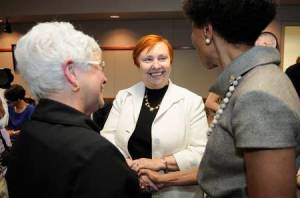The Human Side of Business
Tips for Communicators
Making Communication Technology Work for You at Work
 Dr. Tracy Russo, the director of the Communication Studies MA program at the Edwards Campus, delivered a talk last month titled “Making Communication Technology Work for You at Work” as part of the KU Edwards Campus’s Professional Edge series. The turnout was fantastic: over 80 people showed up to learn more about the challenges and benefits associated with communication technologies in the workplace.
Dr. Tracy Russo, the director of the Communication Studies MA program at the Edwards Campus, delivered a talk last month titled “Making Communication Technology Work for You at Work” as part of the KU Edwards Campus’s Professional Edge series. The turnout was fantastic: over 80 people showed up to learn more about the challenges and benefits associated with communication technologies in the workplace.

Tracy Russo, Communication Studies. ©The University of Kansas/Office of University Relations. Credit: Doug Koch.
Professor Russo’s take-away was simple, but it’s one that not all of us think about every day: “The technology isn’t the communication—your message is the communication.” She argued that there is no such thing as an inherently bad or good method of communication, just media that are more or less effective in different contexts.
After reviewing the affordances and social costs of the most common types of communication technology—in-person meetings, phone calls, texting, voice mail, paper, and email—Professor Russo pointed out that workplace cultures can occasionally get “stuck” on various types of communication to their detriment.
For example, if two office mates are emailing each other while they’re sitting in the same room, then they’re probably missing out of the efficiency and relationship-building capabilities of speaking face-to-face. Similarly, if an office tried to communicate entirely by in-person meetings without relying on email or paper, there would be a lack of record-keeping on what was being done and efficiency would be eaten up by a constant stream of meetings.
Professor Russo encouraged the audience to avoid depending too much on one mode of communication and to always remember the social costs and social benefits of each communication technology. She proposed four essential rules for efficiently communicating with others:
1) “Take the time to focus on the purpose of the communication—not for you, but for the receiver of the message.” What will your recipient get out of the message that could benefit him or her? Thinking in this way will ensure that your messages always have a “hook” for your audience.
2) Consider your audience and personalize the message to their needs, preferences, and limitations. Sending out the same message in the same way to a large group of people guarantees that at least some individuals will get left behind.
3) Choose your medium strategically, keeping in mind the message, what action you want the other party to take, and the other party’s needs and preferences. What can be conveyed effectively in a text message, an email, and a meeting are all very different!
4) Stop and think before you send the message. Give yourself the time to consider its layers and implications. Those few extra seconds each day will lead to much greater effectiveness and stronger relationships in the long run.
Do you have any tips of your own related to communication and technology in the workplace? Share them with us in the comments!
Office Politics: Taboo or Tool?
What do you think when you hear “office politics”? Most people associate office politics with insincere flattery, putting an individual’s success over the group’s, or getting by on charm instead of ability.
But have you ever considered the positive side of politics? Sure, politics may involve purposefully currying favor, but at its best, that social work can serve to make an individual more effective at shaping goals, building relationships with teammates, and maintaining a collaborative workforce where individuals buy into the larger group’s goals.

Credit: David McKinney/KU University Relations. ©The University of Kansas/Office of University Relations
But office politics is something that, according to Jeffrey Pfeffer, professor of organizational behavior at Stanford University’s Graduate School of Business, isn’t given the educational attention it deserves. Professor Pfeffer recently wrote on article on this topic for The Wall Street Journal. In “Don’t Dismiss Office Politics—Teach It,” Pfeffer reminds us that “Many promising executives derail sometime during their careers, often because they weren’t very good at office politics.” Pfeffer reports that many managers see avoiding office politics as “a badge of honor,” but that
They couldn’t be more wrong. Research finds that a person’s political skills are key to building a successful career—for the good of both themselves and their company. When talented executives combine a knowledge of what their company needs with an ability to get things done, everyone benefits.
Pfeffer also works to redefine “office politics” by highlighting the positive effects of communicating well with others and building healthy relationships with stakeholders at all levels, from executives to subordinates to clients:
Being politically savvy is not about pushing others down or being untruthful to advance your own cause. Instead, it means building networks—relationships—with people inside and outside your company who can provide useful information and assistance. It means not picking fights over issues that aren’t critical. It means informing others in the company about your contributions and accomplishments, and asking for advice and help, particularly from those senior to you. Self-serving? Sure. But there’s nothing wrong with that. If you are going to make a difference, you need to have power.
Fortunately, Pfeffer believes that “Power skills, like all skills, can be taught.” He suggests that employees looking for managerial roles pursue mentoring, coaching, and coursework to develop effective political skills.
Have you ever been in a situation where your political skills—or lack thereof!—determined your success in a particular project?
Nancy Duarte: How You Communicate Can Help You Change the World
We’ve all struggled with making plain old business presentations into something that can inspire real change, but Nancy Duarte offers one invaluable trick in her March 2011 TED talk: tell a story.
Nancy Duarte’s talk at TEDx East from Duarte Design on Vimeo.
Duarte, author of slide:ology: The Art and Science of Creating Great Presentations and the CEO of Duarte Design, describes how stories–transformative timelines with a beginning, a middle, and an end–can make ideas come to life for an audience. She asserts that the world’s best, most effective speeches follow an oscillating pattern that moves repeatedly between “what is” and “what could be.” To illustrate this pattern, she maps out Steve Jobs’s first iPhone launch speech from 2007 and Dr. Martin Luther King’s “I Have a Dream” speech to show how real presentations consistently compare the present to the possible future.

Duarte's Pattern of Presentations. Image from http://www.thespeakerpoint.com/.
Duarte’s talk offers great insight into what makes presentations successful. What tricks do you use to make your presentations work? How do you bring your ideas to life so that you can change the world?
Civility in the Workplace
Civility, or rather incivility, has become a hot topic. From published pundits to folks in the grocery store check-out line, there’s a lot of complaining about the ways people talk to and about one another, especially at work. Many observers are alarmed that incivility may seem increasingly normal, especially given its continuing presence in the media, in sitcoms to CSPAN.
In the most recent edition of Spectra, a publication of the National Communication Association, Janie Harden Fritz notes that incivility is costly to organizations, both in terms of people and productivity. She writes
If left unchecked, incivility harms workplace relationships, costing managerial time and effort spent in damage control. Incivility takes attention away from work, compromising the trust needed for successful cooperative activity. .. Communication marked by incivility – rudeness, impoliteness, failure to treat others with at least minimal respect – distracts us from tasks, increases stress, and infects the organizational climate, creating a toxic matrix of distrust and cynicism that transforms enthusiasm into reluctant resignation and daily routines into drudgery.
At the heart of civility is consideration of audience and of thinking strategically about what we want to accomplish, choosing appropriate approaches. Incivility and civility highlight the power of messages to harm and to heal.
Fritz argues that electronic communication, with its accessibility and speed, provides more opportunities for incivility, particularly in its blurring of public and private discourse. Given the complexity of our organizational lives and the human reality that we do have bad days sometimes, our workplaces probably never will be free of thoughtless or deliberate incivility. But efforts to practice professional civility create a backdrop of respect and goodwill that may sustain us through both the mundane and difficult times.
JD Schramm on Consistency in Communication
This week, we stumbled across “A Model of Consistency,” a blog post from JD Schramm. Shramm, a member of the Harvard Business Review‘s blog network, writes about a former professor who sent his students and friends monthly newsletters year in, year out, to the tune of 467 issues before he retired. It’s a fun read, and Schramm offers a valuable question:
What does consistent communication mean for you?
As we kick off our new blog here at Com. Studies, we naturally have consistency in communication on our minds. In the world of online, written communications, what types of consistency are important to you? What do you look for when you decide to follow a blog?
Aristotle once said that
We are what we repeatedly do. Excellence then, is not an act, but a habit.
What habits can we, and all online communicators, cultivate to produce excellent content and bring our readers back for more?


